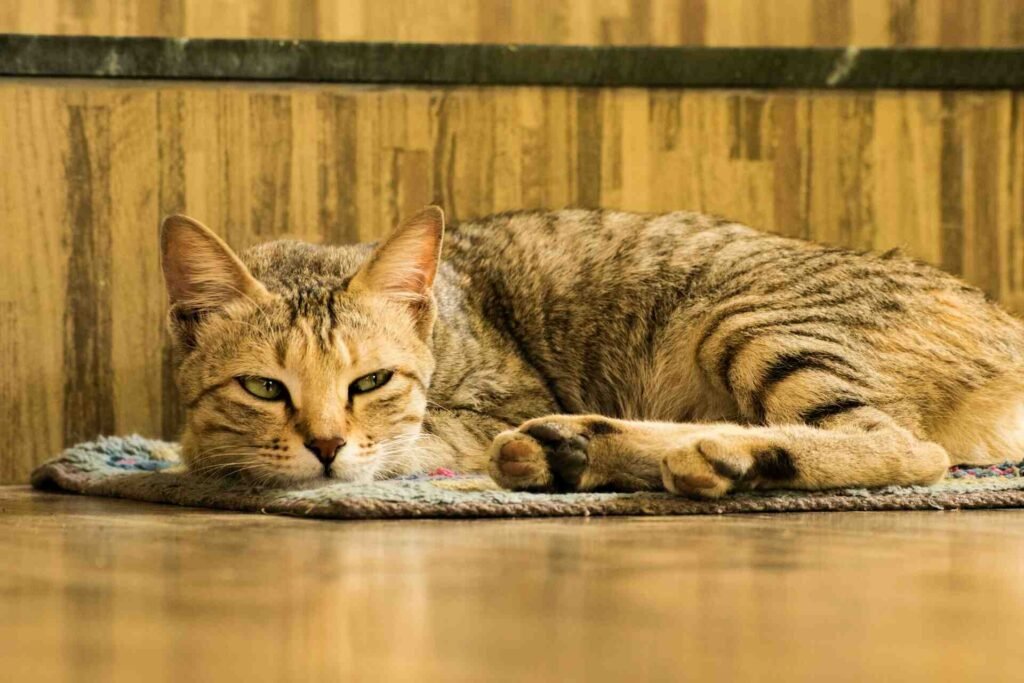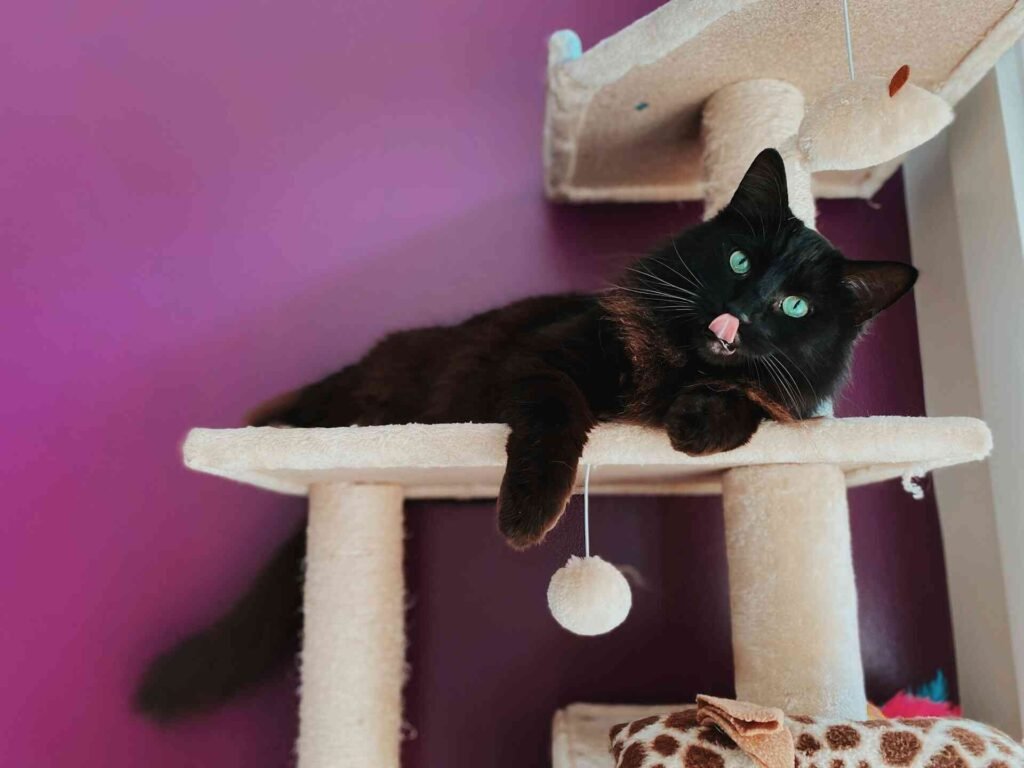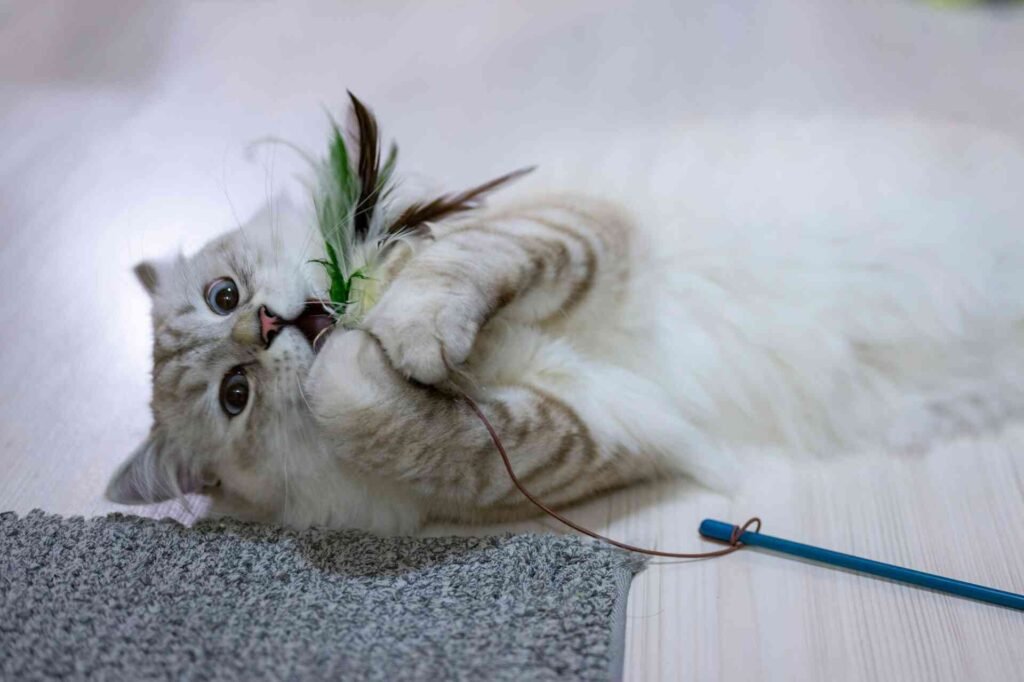That knocked-over plant? The 2 AM zoomies? The constant meowing when you’re trying to work? These aren’t just your cat being difficult, they might be crying out for mental stimulation. As a devoted cat parent, you’ve probably wondered if your feline friend is truly happy lounging around the house all day. The truth is, domestic cats retain the same hunting instincts and intelligence as their wild ancestors, and without proper outlets for these natural behaviors, they often develop what veterinarians call “problem behaviors.”
But don’t worry! We’ve dug through the latest feline behavior research to bring you this guide to identifying and solving cat boredom. By the end, you’ll know exactly how to transform your home into a feline paradise that keeps your kitty mentally sharp and physically active.

Why Cat Enrichment Matters More Than You Think
Before we get into the signs of boredom, let’s understand why enrichment is so crucial for our feline companions. Despite their reputation for being low-maintenance pets, cats are naturally curious predators with complex needs.
According to the American Association of Feline Practitioners, environmental enrichment isn’t just a nice-to-have, it’s essential for preventing behavior problems and health issues in indoor cats. Dr. Tony Buffington’s research has shown that enriched environments can significantly reduce stress-related conditions like feline idiopathic cystitis in indoor cats.
In the wild, cats spend 6-8 hours daily hunting, exploring, and problem-solving. Our pampered house cats still have those instincts but often lack appropriate outlets. This mismatch between natural drives and available opportunities creates what behaviorists call an “enrichment gap.”
9 Subtle Signs Your Cat Is Crying Out for Stimulation
How do you know if your cat is suffering from boredom? Look for these telltale signals that your feline friend needs more enrichment in their life:
1. Excessive Grooming or Hair Loss
Have you noticed bald patches on your cat’s belly or legs? While medical issues like allergies should always be ruled out first, over-grooming can be a stress response to boredom. Psychogenic alopecia (stress-induced hair loss) is frequently associated with understimulated indoor environments, particularly in high-energy breeds. Providing appropriate outlets for natural behaviors can significantly reduce this compulsive grooming response and allow fur to regrow in affected areas.
2. Unprovoked Aggression Toward People or Other Pets
Those surprise ankle attacks or ambushes on other household pets might not be random. Without appropriate outlets for hunting instincts, many cats redirect their predatory behavior toward the only moving targets available, you and other pets. This “play aggression” is actually your cat’s way of saying they need more appropriate hunting opportunities.
3. Destructive Scratching Beyond Normal Territory Marking
While some scratching is normal territorial behavior, excessive damage to furniture throughout your home often indicates a bored cat. They’re literally clawing for stimulation! The Cornell Feline Health Center explains that scratching serves multiple purposes, it’s play, territorial marking, and display of confidence all in one. If your cat is shredding the couch or curtains, it might also be time for a claw trim. Here’s how often you should trim your cat’s claws and why it matters.
4. Middle-of-the-Night Activity Spikes
The infamous “2 AM zoomies” aren’t just your cat being difficult. Cats are crepuscular hunters (most active at dawn and dusk), and without sufficient daytime activity, that energy has to go somewhere. Ellis et al. in their AAFP and ISFM feline environmental needs guidelines recommend regular play sessions throughout the day to help normalize activity patterns and reduce nighttime hyperactivity.
5. Excessive Vocalization Without Obvious Cause
Is your cat suddenly more talkative? While some breeds are naturally vocal (looking at you, Siamese), a sudden increase in meowing without an apparent reason often signals boredom. Your cat is literally asking for something to do!
6. Over-Eating or Begging for Food When Not Hungry
Many cats eat out of boredom, just like humans might reach for snacks when there’s nothing else to do. This “emotional eating” can lead to obesity, a significant health issue for domestic cats. Food-dispensing toys and puzzle feeders can help address this issue by making cats work for their food, slowing consumption and providing mental stimulation simultaneously. Simply changing how you feed your cat can transform mealtime from a two-minute gulping session into an enriching 20-minute activity that satisfies both hunger and hunting instincts.
7. Lethargy and Excessive Sleeping (Beyond Normal Cat Naps)
Yes, cats sleep a lot, typically 12-16 hours daily. But there’s a difference between healthy sleep and depression-linked lethargy. If your cat barely moves from one sleeping spot all day and shows little interest in their surroundings, they may be experiencing the feline equivalent of depression due to understimulation.
8. Obsessive Attention-Seeking Behaviors
Does your cat constantly interrupt your Zoom calls or step on your keyboard? While cute at first, persistent attention-seeking can indicate that your cat lacks alternative sources of stimulation and engagement.
9. Litter Box Issues With No Medical Cause
After ruling out medical problems with your veterinarian, inappropriate elimination can be linked to environmental stress and boredom. The Ohio State University College of Veterinary Medicine’s Indoor Cat Initiative recommends environmental enrichment as part of their multimodal approach to addressing litter box issues not tied to medical conditions, as enrichment helps reduce stress-related behaviors in indoor cats.
Creating Your Cat’s Indoor Adventure Zone: A Room-by-Room Guide
Now that you’ve identified the signs, let’s transform your home into a cat paradise that addresses your feline’s natural needs:
The Living Room: Vertical Territory
Cats are natural climbers who feel safest with vertical escape routes. Creating “cat highways” above human traffic gives them security and observation posts.

Quick improvements:
- Install window perches where your cat can safely watch “cat TV” (birds and outdoor activity)
- Add cat shelves that create pathways along walls
- Position a tall cat tree near windows but partially against walls (cats prefer security on multiple sides)
Pro tip: Place these vertical elements so cats can make complete circuits around rooms without touching the floor, this mimics natural patrolling behavior and dramatically increases their perceived territory size.
The Dining Area: Hunting Simulation
Cats hunt small prey multiple times daily in nature, you can simulate this with feeding strategies that make mealtime an engaging activity.
Quick improvements:
- Replace food bowls with puzzle feeders that require problem-solving
- Hide small portions of food around your home for “hunting” expeditions
- Use treat-dispensing toys that release kibble when batted around
The Bedroom: Safe Retreat and Play Zone
Even the most playful cats need secure retreats. Your bedroom can serve dual purposes as both sanctuary and play space.
Quick improvements:
- Create “cat caves” under beds or in closets with soft bedding
- Keep interactive toys stored here for morning play sessions when cats are naturally active
- Use synthetic feline pheromone products to create a sense of security
The Home Office: Mental Stimulation Hub
Working from home? Make your office cat-friendly with activities that keep your cat engaged while you work.

Quick improvements:
- Set up a bird feeder outside your office window
- Create a rotating toy station with items switched weekly to prevent boredom
- Install a small cat shelf at desk height so your cat can be near you without disrupting work
Environmental Enrichment Comparison: What Works Best?
Not all enrichment strategies are created equal. Here’s how different approaches stack up against each other:
| Enrichment Type | Effectiveness | Cost | Time Investment | Best For |
|---|---|---|---|---|
| Interactive Play | ★★★★★ | $ | 15-20 min daily | All cats, especially high-energy breeds |
| Food Puzzles | ★★★★☆ | $-$$ | 5 min setup | Food-motivated cats, weight management |
| Cat TV/Videos | ★★☆☆☆ | Free-$ | No time | Supplemental only, not primary enrichment |
| Vertical Space | ★★★★★ | $$-$$$ | One-time setup | Multi-cat homes, territorial cats |
| Solo Toys | ★★☆☆☆ | $ | Replace monthly | Supplemental only |
| Outdoor Catios | ★★★★★ | $$$$ | One-time setup | Indoor cats craving outdoor access |
| Training Sessions | ★★★★☆ | $ | 5-10 min daily | Intelligent breeds, young cats |
| Sensory Gardens | ★★★☆☆ | $$ | Seasonal | Cats with outdoor history |
DIY Enrichment: 5 Budget-Friendly Cat Toys You Can Make Today
You don’t need to spend a fortune to enrich your cat’s environment. Here are five proven toys you can make from household items:
- Toilet Roll Puzzle Feeder: Fold in the ends of empty toilet paper rolls and cut small holes in the sides. Place treats inside and let your cat work to extract them.
- Sock Fish: Fill an old sock with dried catnip and a crinkly plastic bag, then tie off the end and sew or glue felt fins to create a fish shape that’s perfect for kicking.
- Box Maze: Connect several cardboard boxes with cut-out doorways. Add peek holes and hiding spots for treats to create an explorable territory.
- Paper Bag Crinkle Toy: Place a paper bag on its side with a few treats inside. The noise and movement make it irresistible to most cats.
- Wine Cork Batting Toys: Attach natural wine corks to strings and hang them at cat height for batting practice that satisfies predatory instincts.
Remember to supervise play with homemade toys and replace them if they start to fall apart.
The Cat Enrichment Schedule: Making It Sustainable
The key to successful enrichment is consistency. Here’s a realistic schedule that fits into busy human lives:

Morning (5 minutes):
- Quick wand toy play session while coffee brews
- Hide breakfast in puzzle feeders before leaving for work
Daytime (set-and-forget):
- Leave window perches accessible
- Rotate which solo toys are available
- Set up a bird feeder visible from indoor perches
Evening (10-15 minutes):
- Interactive play session mimicking prey movements
- Training session with clicker and treats
- Hide treats or portion of dinner for hunting
Weekly (30 minutes):
- Deep clean and refresh catnip toys
- Rearrange elements of your cat’s environment
- Introduce one new enrichment element
Frequently Asked Questions
Q: My cat doesn’t play with toys. Is something wrong with them?
A: Not necessarily! Each cat has individual preferences. Try different types of toys, some prefer ground-based toys that mimic mice, while others prefer aerial toys like feathers on wands. Watch what your cat naturally stalks or pounces on for clues about their preferences.
Q: How much play does an adult cat really need?
A: Most adult cats benefit from at least two 10-15 minute interactive play sessions daily. Senior cats may need shorter sessions, while kittens and young adults may need three or more sessions to stay behaviorally healthy.
Q: Can I just get another cat to solve the boredom problem?
A: Adding another cat can help in some cases, but it’s not a universal solution. Some cats are naturally solitary and may become more stressed with a feline companion. If you do add another cat, you’ll need to increase resources (vertical space, feeding stations, toys) to prevent competition.
Q: My cat has special needs/mobility issues. How can I keep them stimulated?
A: For cats with limited mobility, focus on sensory enrichment like new scents (silver vine, valerian), gentle brushing sessions, or window perches where they can safely watch outdoor activity. Food puzzles that don’t require extensive movement can also provide mental stimulation.
Q: How do I know if my enrichment efforts are working?
A: Track problem behaviors before and after implementing changes. You should notice a reduction in unwanted behaviors within 2-3 weeks, along with positive signs like more normal sleep patterns, appropriate play, and decreased aggression or anxiety.
Conclusion: A Stimulated Cat is a Happy Cat
Creating an enriched environment for your cat isn’t just about preventing problem behaviors, it’s about helping them thrive as the complex, fascinating predators they are. Even small changes can make a significant difference in your cat’s mental health and happiness.
Remember that enrichment isn’t a one-size-fits-all approach. Observe what engages your unique cat and build on those preferences. The effort you put into environmental enrichment will reward you with a healthier, more behaviorally balanced companion who expresses their natural instincts in appropriate ways.
Your cat’s wild ancestors spent their days hunting, climbing, exploring, and problem-solving. While we can’t release our beloved pets into the wilderness, we can bring elements of that natural lifestyle into our homes. Your cat will thank you with fewer behavior problems and more of those magical moments of feline contentment that make cat companionship so special.
Looking for more? Explore our Cat Toys & Enrichment section for more tips like this, visit the Blog for fun and insightful reads, or browse our full Cat Category for everything feline-related, from care to comfort.
Disclaimer: This article is for informational purposes only and does not substitute for professional veterinary advice. Always consult your veterinarian for diagnosis and treatment tailored to your cat’s individual needs. Please verify current product information directly on the retailer’s site before purchasing.
References
American Association of Feline Practitioners. (2021). 2021 AAFP Feline Senior Care Guidelines. Journal of Feline Medicine and Surgery, 23(7), 613-638. https://journals.sagepub.com/doi/full/10.1177/1098612X211021538
Buffington, C. A. T. Environmental Enrichment Resources and References. The Ohio State University College of Veterinary Medicine. https://indoorpet.osu.edu/veterinarians/environmental-enrichment-resources-and-references
Buffington, C. A. T. (2011). Idiopathic cystitis in domestic cats—beyond the lower urinary tract. Journal of Veterinary Internal Medicine, 25(4), 784-796. https://doi.org/10.1111/j.1939-1676.2011.0732.x
Cornell Feline Health Center. (2018). Feline Behavior Problems: Destructive Behavior. Cornell University College of Veterinary Medicine. https://www.vet.cornell.edu/departments-centers-and-institutes/cornell-feline-health-center/health-information/feline-health-topics/feline-behavior-problems-destructive-behavior
Ellis SLH, Rodan I, Carney HC, et al. AAFP and ISFM Feline Environmental Needs Guidelines. (2013). Journal of Feline Medicine and Surgery. 15(3), 219-230. https://journals.sagepub.com/doi/10.1177/1098612X13477537
Check out our most recent articles!
- Cats and Snow: Why Some Love It and Others Don’tSnow isn’t just uncomfortable for many cats, it’s a complete sensory overload. From cold paw pads to wet fur and changed landscapes, winter challenges feline comfort in unexpected ways. Learn how to recognize stress signals and create cozy alternatives for snow-averse cats.
- Christmas Names for Cats: From Classic to Creative Holiday IdeasNaming your holiday cat goes beyond festive fun. Discover why Christmas-inspired names age beautifully, spark instant connections with fellow pet lovers, and capture the warmth cats bring to our homes during the most magical season of the year.
- How to Keep Your Cat From Drinking Christmas Tree WaterYour cat’s obsession with Christmas tree water isn’t just annoying, it’s genuinely dangerous. From harmful bacteria to toxic additives, that festive reservoir poses real health risks. Discover practical solutions that protect your pet without sacrificing holiday cheer.
- Best Cat Toys for Christmas: The Ultimate Guide to Holiday JoyNot all Christmas gifts end up under the tree, some get batted across the floor at 3 AM. Explore the wonderful world of holiday cat toys that match your feline’s personality, from plush companions for cuddlers to high-tech options for the eternally energetic.
- Are Fake Christmas Trees Safe for Cats? A Holiday Safety GuideThat beautiful Christmas tree might look festive to you, but to your cat, it’s an irresistible climbing gym with built-in toys. Find out whether artificial trees are truly safer for cats and discover the hidden dangers lurking in your holiday decorations.
- The Best Christmas Gifts for Cats That’ll Actually Get Used (Not Ignored)Not all Christmas gifts land on the nice list with our feline friends. Discover which presents actually spark joy in cats and which ones end up gathering dust under the couch by New Year’s Day.
- Do Cats Eat Less in Winter? How Cold Weather Affects Your Cat’s AppetiteWinter brings more than just cold weather, it can completely change your cat’s eating habits. From bored indoor cats to outdoor ferals fighting to survive, discover what’s really driving those appetite changes and how to respond appropriately.
- Are Humidifiers Good for Cats? A Complete Safety & Health GuideNot all humidifiers are cat-safe, and some common practices could be toxic. Learn why cool mist beats warm mist, why essential oils are dangerous for felines, and how proper humidity levels between 30-50% support your cat’s breathing and coat health.
- How to Protect Leather Furniture From Cats (Without Losing Your Mind)Leather furniture and cat claws seem like natural enemies, but they don’t have to be. Learn why your cat is drawn to that expensive couch in the first place, and how simple redirects can save your furniture while keeping your cat’s natural behaviors satisfied.
- The Best Material for Cat Bowls: Protect Your Cat from BacteriaStainless steel, ceramic, or plastic, which material keeps your cat healthiest? We break down the science behind cat bowl materials, revealing why some harbor bacteria and others last decades without compromising your feline’s wellbeing.










